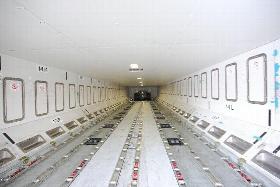

Traffic volumes are up five per cent on a year ago, thanks to a solid rise in July, and demand in commodities like semi-conductors, but the rest of 2014 has been flat, according to the International Air Transport Association (IATA) quarterly cargo market analysis.
It says Asian volumes have improved after a weak first quarter, while US consumer confidence is boosting demand. Europe remains weaker, which is blamed on the Russia-Ukraine conflict. Business confidence is up but rates of improvements are weaker than 2013. The US economy was impacted by extreme weather at the beginning of the year but rising employment and growth in manufacturing has helped. The Eurozone is expected to recover more strongly in 2014 though tightening fiscal policies are expected to keep growth below emerging markets.
IATA says: “Airfreight volumes continue to show solid gains on a year ago, supported by economic improvements in some regions, but jet fuel prices and overall weakness in yields kept cargo financial performance from improving so far this year.”
It says the rate of airfreight growth has not improved on a year ago and is still below the pre-financial crisis peak while seafreight has seen improvements, particularly between the Americas and Asia.
According to IATA, demand conditions in the third quarter improved compared to the first half. In July, an IATA survey of heads of cargo found that they expected stronger growth in traffic volumes over the next 12 months and increases in cargo yields. More than half said it would improve in the next 12 months and 31 per cent believe yields will improve in the next year. Jet fuel prices have eased to $120 a barrel, because of weakened demand from Europe, causing prices to drop. Prices have come down four per cent at the end of 2013, but in the first quarter remained within the three-year high range of $135 per barrel. The average price for 2014 is $123 per barrel, which is below the August 2008 peak of $180 dollars per barrel.
Year-on-year growth in freight tonnes by route area has been variable but June, the most recent month available, has seen some of the slowest increases of the year, or in some cases, the largest declines.
The South Atlantic and North and Mid Pacific saw the biggest year-on-year rises of 20.1 per cent and 15.1 per cent, respectively. Europe-Middle East declined in April, May and June by 3.1 per cent, 4.2 per cent and 10.7 per cent, respectively. It had grown by four per cent, 1.9 per cent and 1.3 per cent in January, February and March, respectively.
IATA says the load factor has risen throughout the year because of increasing bellyhold capacity. Year-to-date it is 45.2 per cent, helped by fleet reductions. IATA says it expects a 14 per cent increase of deliveries of new twin-aisle aircraft with bellyhold capacity. The widebody bellyhold fleet has increased to 3,700 aircraft in August, though freighters have increased throughout the year to 2,700, but are still down from the peak of 3,100 in December 2005.












